Caucasus Campaign
The Caucasus Campaign comprised armed conflicts between the Ottoman Empire and the Russian Empire, later including Azerbaijan, Armenia, the Central Caspian Dictatorship and the British Empire as part of the Middle Eastern theatre during World War I. The Caucasus Campaign extended from the South Caucasus to the Armenian Highlands region, reaching as far as Trabzon, Bitlis, Mush and Van. The land warfare was accompanied by the Russian navy in the Black Sea Region of the Ottoman Empire.
On February 23, 1917, the Russian advance was halted following the Russian Revolution, and later the Russian Caucasus Army disintegrated and was replaced by the forces of the newly established Armenian state, comprising Armenian volunteer units and irregular units which had previously been part of the Russian Army. During 1918 the region also saw the establishment of the Central Caspian Dictatorship, the Republic of Mountainous Armenia and an Allied intervention force, nicknamed Dunsterforce, composed of troops drawn from the Mesopotamian and Western Fronts. The Ottoman Empire and German Empire had a hot conflict at Batumi with the arrival of the German Caucasus Expedition whose prime aim was to secure oil supplies.
On March 3, 1918, the campaign terminated between the Ottoman Empire and Russia with the Treaty of Brest-Litovsk and on June 4, 1918, the Ottoman Empire signed the Treaty of Batum with Armenia. However, the armed conflicts continued as Ottoman Empire was still engaged with the Central Caspian Dictatorship, Republic of Mountainous Armenia and Dunsterforce of the British Empire until the Armistice of Mudros was signed on October 30, 1918.
The Armenian Genocide is intertwined with the events of this campaign.
Background
The main objective of the Ottoman Empire was the recovery of territory in the Caucasus, including regions captured by the Russian empire as a result of the Russo-Turkish War, 1877-78. The strategic goals of the Caucasus Campaign for Ottoman Forces was to retake Artvin, Ardahan, Kars, and the port of Batum. A success in this region would mean a diversion of Russian forces to this front from the Polish and Galician fronts.[5] A Caucasus Campaign would have a distracting effect on Russian forces. The plan found sympathy with German advisory. Germany supplied the missing resources and the Ottoman 3rd Army's manpower was used to achieve the desired distraction.[6] War Minister Enver Pasha hoped a success would facilitate opening the route to Tiflis and beyond with a revolt of Caucasian Muslims.[5] The Ottoman strategic goal was to cut Russian access to the hydrocarbon resources around the Caspian Sea.[7]
Russia viewed the Caucasus front as secondary to the Eastern (European) front. The Eastern Front had the most Russian manpower and resources. Russia had taken the city of Kars from the Turks in 1877 and feared an Ottoman advance into the Caucasus aimed at retaking Kars and the port of Batum. In March 1915 the Russian foreign minister Sergey Sazonov stated in a meeting with British ambassador George Buchanan and French Ambassador Maurice Paléologue that a lasting postwar settlement demanded full Russian possession of the capital city of the Ottoman Empire, the straits of Bosphorus and Dardanelles, the Sea of Marmara, southern Thrace up to the Enos-Midia line as well as parts of the Black Sea coast of Anatolia between the Bosphorus, the Sakarya River and an undetermined point near the Bay of Izmit.[8] The Russian Tsarist regime planned to replace the Muslim population of Northern Anatolia and Istanbul with more reliable Cossack settlers.[9]
The British worked with Russian revolutionary troops to prevent Enver Pasha's goal of establishing an independent Transcaucasia. The Anglo-Persian Oil Company was in the proposed path of Ottoman ambitions, which owned the exclusive rights to work petroleum deposits throughout the Persian Empire except in the provinces of Azerbaijan, Ghilan, Mazendaran, Asdrabad and Khorasan.[7] In 1914, before the war, the British government had contracted with the company for the supply of oil-fuel for the navy.[7]
Forces
Ottomans
The Ottomans had one army based in the region, the 3rd Army. In 1916 they sent reinforcements and formed the 2nd Army. At the beginning of the conflict, the combined forces of the Ottomans ranged from 100,000 to 190,000 men. Many were poorly equipped.
Russia
Before the war, Russia had the Russian Caucasus Army stationed here, with 100,000 men under the nominal command of the Governor General of the Caucasus Illarion Vorontsov-Dashkov. The real commander was his chief of staff General Nikolai Yudenich. At the onset of the Caucasus Campaign, the Russians had to redeploy almost half of their forces to the Prussian front due to the defeats at the Battle of Tannenberg and the Masurian Lakes, leaving behind just 60,000 troops. However, This Army had lots of Armenian support. It had Armenian generals Nazarbekov, Silikian, and Pirumov who stayed in Caucasia. The Russian Caucasus Army dissipated in 1917 as the regular Russian regiments deserted the front line after the revolution. By 1917, when the Russian Caucasus Army disintegrated, there were 110,000–120,000 soldiers of Armenian ethnicity.[10] This number approached to 150,000 for the total Armenians (including other Allied forces) for Near East where opposing to Ottoman forces.[11]
Armenia
In the summer of 1914, Armenian volunteer units were established under the Russian Armed forces. It was initially established as detachment units (rather than part of Russian Caucasus Command) under the Viceroyalty of the Caucasus. These forces were commanded by Andranik Ozanian. Other leaders included Drastamat Kanayan, Hamazasp Srvandztyan, Arshak Gafavian, and Sargis Mehrabyan. An Ottoman representative Karekin Bastermadjian (Armen Karo) was also united to this force. Initially they had 20,000 men, but throughout the conflicts it was reported that their number increased. At the turn of 1916, Nikolai Yudenich decided to either merge these units under the Russian Caucasus Army or dismantle them.
The Armenian national liberation movement commanded the Armenian Fedayee (Armenian: Ֆէտայի) during these conflicts. These civilian forces generally organized around famous leaders, such as Murad of Sebastia (Armenian: Սեբաստացի Մուրատ). These were generally referred to as Armenian partisan guerrilla detachments. Boghos Nubar, the president of the Armenian National Assembly, declared to Paris Peace Conference, 1919 that they accompanied the main Armenian units. The Russian defensive line from Van to Erzincan was organized through these units.
In December 1917, The Dashnaks of the Armenian national liberation movement through the Armenian Congress of Eastern Armenians established a military force. The corps realigned themselves under the command of General Tovmas Nazarbekian. Drastamat Kanayan was assigned as a civilian commissioner. The frontline had three main divisions: Movses Silikyan, Andranik Ozanian and Mikhail Areshian. Another regular unit was under Colonel Korganian. The line from Van to Erzincan was organized through these units. It was mentioned that Adrianic had 150,000 men.[12] After declaration of the First Republic of Armenia Nazarbekian became the first Commander-in-chief of the whole Armenian state.
Others
Lionel Dunsterville was appointed in 1917 to lead an Allied force of under 1,000 Australian, British, Canadian and New Zealand troops, accompanied by armored cars.
- Forces engaged at the Campaign
 1914, Russian Caucasus Army at Sarikamish
1914, Russian Caucasus Army at Sarikamish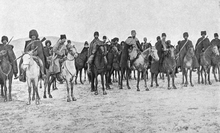
 1914, Ottoman 3rd Army with winter gear
1914, Ottoman 3rd Army with winter gear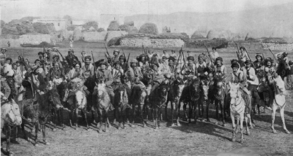 1915, Troops of Kurdish Cavalry
1915, Troops of Kurdish Cavalry
Operations
1914
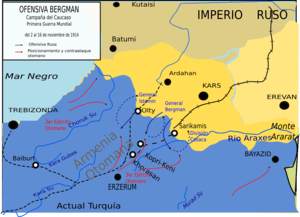
On November 1, the Bergmann Offensive, Russians crossed the frontier first. They planned to capture Doğubeyazıt and Köprüköy.[6] The official Russian declaration of war to Ottoman Empire came on November 2.[13] The established force for this goal was 25 infantry battalions, 37 cavalry units and 120 artillery guns. It had two wings. On the right wing, the Russian I Corps crossed the border and moved from Sarikamish toward the direction of Köprüköy. They reached Köprüköy on November 4. On the left wing, the Russian IV Corps moved from Yerevan to Pasinler Plains. The commander of 3rd Army, Hasan Izzet was not in favor of an offensive action in the harsh winter conditions. His plan was to remain in defense and launch a counterattack at the right time. This was overridden by the War Minister Enver Pasha. On November 7, the 3rd Army commenced its offensive with the participation of the XI Corps and all cavalry units. This force was supported by a Kurdish Tribal Regiment. The cavalry failed to execute the encircling and the Kurdish Tribal Regiment proved to be unreliable. Russians gained territory after the withdrawal of the 18th and the 30th Divisions. Ottoman forces managed to maintain their positions at Köprüköy. By November 12, the IX Corps with Ahmet Fevzi Pasha reinforce the XI Corps on the left flank. The 3rd Army began to push the Russians back with the support of the cavalry. The 3rd Infantry Regiment managed to invade Köprüköy after the Azap Offensive between November 17 to 20. By the end of November, the front had stabilized with the Russians clinging to a salient 25 kilometers into Ottoman Empire along the Erzurum-Sarikamish axis. The Russian success was along the southern shoulders of the offensive where Armenian volunteers were effective and took Karaköse and Doğubeyazıt.[14] Doğubeyazıt was the northern neighbor of Van Province. Ottoman casualties were high: 9000 killed, 3000 taken prisoner and 2800 deserters.
During December, Nicholas II of Russia visited the Caucasus Campaign. The head of the Armenian Church, along with the president of the Armenian National Council of Tiflis, Alexander Khatisyan, received him:
From all countries Armenians are hurrying to enter the ranks of the glorious Russian Army, with their blood to serve the victory of the Russian Army... Let the Russian flag wave freely over the Dardanelles and the Bosporus, Let your will the peoples [Armenian] remaining under the Turkish yoke receive freedom. Let the Armenian people of Turkey who have suffered for the faith of Christ received resurrection for a new free life...[15]— Nicholas II of Russia
On December 15, 1914, at the Battle of Ardahan, the city was captured. It was an operation commanded by German Lt. Col. Stange. The mission of Stange Bey Detachment was to conduct highly visible operations to distract and pin Russian units. Stange Bey's initial mission was to operate in the Chorok region. The unit was materially assisted by the rebellious Adjars of the country, who seized the road. Later Enver modified the original plan toward supporting the Battle of Sarikamish.[16] It was ordered to cut the Russian support link to Sarikamish-Kars line. On January 1, this unit was in Ardahan.
On December 22, at the Battle of Sarikamish, the 3rd Army received the order to advance towards Kars. In the face of the 3rd Army's advance Governor Vorontsov planned to pull the Russian Caucasus Army back to Kars. Yudenich ignored Vorontsov's wishes to withdraw. He stayed to defend Sarikamis. Enver Pasha assumed the personal command of the 3rd Army and ordered it into battle against the Russian troops.
1915
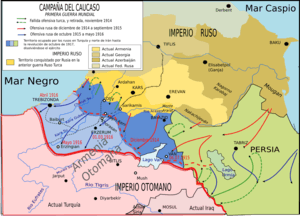
On January 6, the 3rd Army headquarters found itself under fire. Hafiz Hakki Pasha ordered a total retreat. On January 7, the remaining forces began their march towards Erzurum. The resulting Battle of Sarikamish became a stunning defeat. Only 10% of the Army managed to retreat back to its starting position. After this, Enver gave up command. The Armenian volunteer units were definitely a factor in their defeat, as they challenged the Ottoman operations during critical times,[17] and his experience may have been one of the catalysts that led the Three pashas, of which one was Enver, to their decision to conduct the Armenian Genocide only a few months later.[18] Enver blamed this defeat on Armenians living in the region actively siding with the Russians after his return to Constantinople.[19]
On January 18, 1915, the Lt. Col. Stange's unit was recalled from the area around Ardahan. It was to stay behind the lines in the region; only on March 1, 1915 did it regain its initial position.
In February, General Yudenich was praised for the victory and promoted to commander-in-chief of all Russian troops in the Caucasus. The Allies (British and France) asked Russia to relieve the pressure on the Western front. In return, Russia asked the Allies to relieve pressure in the Caucasus by a naval attack. The resulting operations in the Black Sea gave the Russians some respite to replenish their forces. Additionally, actions at the Battle of Gallipoli which aimed at capturing the Ottoman capital helped the Russian forces on this front.[6] On February 12, the commander of the 3rd Army Hafiz Hakki Pasha died of typhus and was replaced by Brigadier General Mahmut Kamil Pasha. Kamil faced the daunting task of putting the Ottoman army back in order. The military planners back in Istanbul were scared of the Russians advancing deeper into the mainland.
During March the strategic situation remained stable. The completely devastated 3rd Army received new blood through reinforcements from the 1st and 2nd Armies, although these supplements were not stronger than a division. The Battle of Gallipoli was draining every Ottoman resource. Meanwhile, the Russians were holding the towns of Eleşkirt, Ağrı and Doğubeyazıt in the south. Military action never escalated above small-scale skirmishes—the Ottomans simply did not have enough forces to secure the whole East Anatolian region.

On April 20, the resistance at the city of Van began. The Armenian defenders protecting 30,000 residents and 15,000 refugees with 1,500 able bodied riflemen who were supplied with 300 rifles and 1,000 pistols and antique weapons. The conflict lasted more than three weeks until the General Yudenich came to rescue them. General Yudenich began an offensive (May 6) into Ottoman territory. One wing of this offensive headed towards Lake Van to relieve the Armenian residents of the Van Resistance. A brigade of Trans-Baikal Cossacks under General Trukhin, and some Armenian volunteers towards Van.[20] On May 21, General Yudenich arrived to the city, received the keys to the city and citadel and confirmed the Armenian provisional government in office, with Aram Manukian as governor. The Fedayee turned over the city of Van. With Van secure, fighting shifted farther west for the rest of the summer.[20]
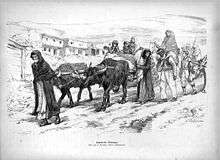
On April 24, Interior minister Mehmed Talat passed the order of April 24 (known by the Armenians as the Red Sunday), claimed that the Armenians in this region organized under the leadership of Russians and rebelled against his government, as they had shown in their securing of Van for Armenian nationalists. The Armenians of the Van Resistance and others which were under the Russian occupation were spared from these arrests, since they had rebelled.
On May 6, the Russian advance began through the Tortum Valley towards Erzurum. The Ottoman 29th and 30th Divisions managed to stop this assault. The Ottoman X Corps counter-attacked the Russian forces. But on the southern part of this advance, Ottoman forces were not as successful as they have been in the north. On May 11 the town of Manzikert had fallen. On May 17, Russian forces entered the town of Van. Ottoman forces continued to be pushed back. Supply lines were being cut, as the Armenian rebellions were causing additional difficulties behind Ottoman lines. The region south of Lake Van was extremely vulnerable. The Turks had to defend a line of more than 600 kilometers with only 50,000 men and 130 pieces of artillery. They were clearly outnumbered by the Russians. The region was mountainous, thus difficult to defend.

On May 27, during the Russian offensive, the interior minister of Talat Pasha ordered a forced deportation of all Armenians out of region with the Tehcir Law to the Syria and Mosul.
By June 13, Russian units were back to their starting line. On June 19, the Russians launched another offensive. This time northwest to Lake Van. The Russians, under Oganovski, launched an offense into the hills west of Manzikert. The Russians underestimated the size of the Ottoman arm, and were surprised by a large Turkish force at the counterattack. Russian forces began to march from Manzikert towards Mush. However, they were not aware of the fact that the Turkish IX Corps, together with the 17th and 28th Divisions was moving to Mush as well. Although the conditions were extremely difficult, the Turks were executing a very efficient operation of reorganization. 1st and 5th Expeditionary Forces were positioned to the south of the Russian offensive force and a “Right Wing Group” was established under the command of Brigadier General Abdülkerim Paşa. This group was independent from the Third Army and Abdülkerim Paşa was directly reporting to Enver Paşa. The Turks were ready to face the Russian attacks.
On September 24, Grand Duke Nicholas was promoted to being charge of all Russian forces in the Caucasus. In reality, he was removed from being Supreme Commander of the Russian Caucasus Army which was the highest executive position [actual conduct of the war] for the Caucasus Campaign. His replacement was General Yudenich. This front was quiet from October till the end of the year. Yudenich used this period to reorganize. Around the start of 1916, Russian forces reached a level of 200,000 men and 380 pieces of artillery. On the other side the situation was very different; the Ottoman High Command failed to make up the losses during this period. The war in Gallipoli was sucking all the resources and manpower. The IX, X and XI Corps could not be reinforced and in addition to that the 1st and 5th Expeditionary Forces were deployed to Mesopotamia. Enver Pasha, after not achieving his ambitions or recognizing the dire situation on other fronts, decided that the region was of secondary importance. As of January 1916, Ottoman forces were 126,000 men, only 50,539 being combat. There were 74,057 rifles, 77 machine guns and 180 pieces of artillery. Ottoman force in Caucasus Campaign was big on the paper, but not on the ground. The Ottomans assumed that the Russians would not bother to attack. This assumption turned out to be false.
1916
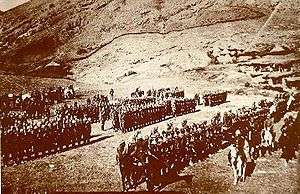
In early January, Yudenich secretly left its winter quarters and marched towards the major Ottoman fort at Erzurum. The winter is not normally a time for military activity in this part of the world. The bitter cold and terrible roads contributed greatly to the annihilation of Enver Pasha's 3rd Army in the previous year. The Russian General Yudenich viewed this as an opportunity to take the Ottomans by surprise. The Russians achieved total surprise and destroyed an Ottoman division that was in winter quarters at Battle of Koprukoy (January 10–18).
On February 16, Mahmut Kamil forced to order the 3rd Army to retreat from the city, as Yudenich had an advantage in numbers against the Ottomans. The difference was not big enough to be decisive, so Yudenich's plan was to attack the center of the Ottoman defenses, with the key attack falling in a weakly held sector. While diversionary attacks held the attention of Mahmut Kamil near Deve-Boyun ridge, Russian forces broke through at Forts Kara-gobek and Tafet.[22] The result was that both rings of the cities' defenses had been penetrated.

In April, the Caucasus army moved in two directions from Erzurum. Part went north and captured the ancient port city of Trabzon. The other part moved in the direction of Mush and Bitlis .These units pushed the 2nd Army deep into Anatolia and defeated the Turks in the Battles of Mush and Bitlis (March 2 – August 24), driving the Ottoman army before it. Bitlis was the last defence point for the Ottoman Army to prevent the Russians from moving into central Anatolia and Mesopotamia.
During July, General Yudenich then countered the Ottoman attack with an offensive of his own towards Erzican with the Battle of Erzincan (July 2–25). On July 2, Erzincan was captured; the Ottoman offensive against Trabzon was halted as they tried to stabilize their front lines. The city was the last stronghold of the Ottoman Empire to prevent the Russians from entering in Anatolia and Mesopotamia.
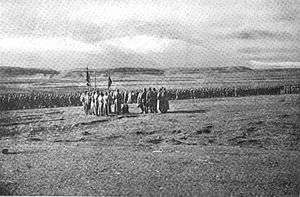
After their defeat, the Ottoman Army gave Mustafa Kemal the organization of the defense of the region in August. The region was controlled by the 2nd Army. When Mustafa Kemal was assigned to his post, the enemy forces were in constant advance. Fighting around the east side of Lake Van continued throughout the summer but was inconclusive. In the earlier periods of the campaign, the XVI Corps managed to take Bitlis and Mush. Ahmet İzzet Paşa decided to attack one week after the conclusion of the Russian offensive. A military force was gathered and sent marching along the coast. The Second Army advanced on August 2. While Nikolai Nikolaevich Yudenich was in the north and pushing the Ottoman 3rd Army, the Ottoman 2nd Army was in the south facing the insurgency and the second branch of Russian army under General Tovmas Nazarbekian and the detachment Armenian volunteer units led by Andranik Ozanian. After fighting from 1–9 August 1916, the Ottoman Army was overwhelmed and the entire region fell to the Russian Empire and Armenian volunteers, and thus an assault on Van was prevented.
By the late September, the Ottoman attack ended. The cost for the 2nd Army was 30,000 killed and wounded. The Russians strengthen their lines. They were strong enough to respond with counteroffensives in two weeks after the launch of the Ottoman offensive. The Russians held up the advance.
From September towards the Russian Revolution, the Russian Navy still dominated the Black Sea.
The rest of the year 1916 was spent by the Turks with organizational and operational changes in the Caucasian front. Fortunately for the Ottoman commanders, the Russians were quiet during this period. The winter of 1916–17 was extremely harsh, which made fighting nearly impossible.
1917
The military situation did not change during the spring of 1917. The Russian plans for a renewed attack never substantiated. Meanwhile, Russia was in political and social turmoil. It was also influencing the army ranks. The chaos caused by the Russian Revolution put a stop to all Russian military operations. The Russian forces began to conduct withdrawals. Neither the Russian soldiers nor the Russian people wanted to continue the war. The Russian army slowly disintegrated. Starting from the spring of 1917, the situation was completely disadvantageous as a renewed typhus, scurvy and similar problems resulting from hygiene and food, became very common in the Caucasian army.[23]
Until the Russian Revolution of 1917, Ottoman Empire's possible operation in Caucasia could not be imagined. After the Battle of Sarikamish, the Ottoman units were "almost always" in disastrous situation trying to hold on the left over regions in the occupied Ottoman lands. The Ottoman forces could not take advantage of this situation during 1917, as their units were not in good shape. Enver moved five divisions out of the region because of the pressure from the British in Palestine and Mesopotamia.
On March 1, the order "Number–1" published by Petrograd Soviet of Workers’ and Soldiers’ Deputies included paragraphs envisioning democratization of the army. This written command enabled military units to elect their representatives. On March 9, 1917, Special Transcaucasian Committee was established with Member of the State Duma V. A. Kharlamov as the Chairman to replace the Imperial Viceroy Grand Duke Nicholas Nikolaevich of Russia (1856–1929) by the Russian Provisional Government as the highest organ of civil administrative body in the Transcaucasia. The new government reassigned General Yudenich to a position in Central Asia. General Yudenich retired from the army following the assignment.
During the Summer, the occupation of Turkish Armenia sponsored a conference to consider emergency measures and adopted plans to form a twenty-thousand-man militia under Andranik to be ready in December 1917. Civilian commissioner Dr. Hakob Zavriev promoted Andranik to Major General. The 1st brigade of Andranik's division was composed of the Erzinjan and Erzurum regiments. The 2nd brigade was composed of the Khnus and Alashkert regiments. The 3rd brigade was of the Van and mounted Zeytoun regiments.

On September 14, 1917, the Russian army in the region was about to completely disintegrate, lost commanding authority, and the tendency of the villagers for plundering had increased. Towards the end of autumn, the Chief General of the Caucasus Front Przhevalskii have already ordered the establishment (reorder) of national Armenian and Georgian forces within the Army to slow down the disintegration. The problems of demobilization of Russian Army (in all fronts Russians had the same problems) would in a way bring the end of the Russian government and help the Bolsheviks to come into power easily. In November 1917, the first government of the independent Transcaucasia was created in Tbilisi as the "Transcaucasian Commissariat (Transcaucasian Sejm)" replaced "Transcaucasian Committee" following the Bolshevik seizure of power in St. Petersburg.
Transcaucasian Sejm was headed by a Georgian Menshevik Nikolay Chkheidze. But Transcaucasian Sejm did not stop the degradation of forces in the region into smaller national forces. While Armenians sending representatives to Transcaucasian Sejm, at the same time the Eastern Armenian leaders at Erivan tried to established an Armenian Army Corps. Armenians had planned to keep their existence based on a political strategy in the way of being supporting the Allies and Russia and to establish their national army with Russian support.[24] General Nazarbekov was selected as the Commanding Officer. Erivan assigned 1st Division under General Christophor Araratov into 1st Erzurum and Erzinjan regiment, 2nd Khnus Regiment, 3rd Yerevan Regiment, and 4th Erzinjan and Yerevan Regiments. Erivan also assigned Colonel Movses Silikyan to 2nd Division with 5th Van Regiment, 6th Yerevan Regiment, 7th and 8th Alexandropol Regiments. The Chief of Staff of the Armenian Corps was General Vickinski. The divisions which comprised four regiments each, had also three regular and one depot regiment. Their total strength was 32,000 enlisted men. Besides these regular structures enabled man was also armed. A 40 to 50 thousand strong force formed from this armed civilian population. Baku alone, Russian army left 160 cannons, 180 machine guns, and 160 million cartridges to Armenians.[25]
On October 23, during the October Revolution the military situation at the "front line" was Ottoman Third Army was protecting the 190 km. area from Munzur Mountains to the Black Sea with the 66 battalions consisting of 30,000 combatants each, 177 machine guns, and 157 cannons. The number of machine guns, of animals, supply, transportation and clothing were all problematic. Russia had strengthened Erzurum and Trabzon. Russia had 9; the Ottomans had 3 planes. The Russian placement of forces were a line from the west of Trabzon, along the Erzincan-Kemah passage, passing through south of Tunceli and Murat waters to Lake Van and to Baskale”. On this line, the Russian army against the Third Army had 86,000 combatants and 146 cannons. The situation was stale.[26]
On December 5, 1917, the armistice of Erzincan (Erzincan Cease-fire Agreement) signed between the Russians and Ottomans in Erzincan that ended the armed conflicts between Russia and Ottoman Empire.[27] Between December to February 7 the regiments of the Armenian Corps were immediately hustled off to the front. They created a spectacle en route, for, to the amazement of the homeward-bound Russian soldiers, they were moving toward, not away from, the forward lines. Russian soldiers left equipment and guns to the newly constructed Armenian national army soldiers. After the nationalization (or democratization for some sources) of these left over forces throughout 1917, there was no effective Russian military force by the end of 1917 in the region.
At the turn of 1918, Allied Powers, Cossacks in the south, Georgians, Pontic Greeks, and Armenians were willing to build a resistance line against the Ottomans through gathering in the region. In case of an agreement between Russia and Ottoman Empire, this was the only strategy to continue fighting against the Ottomans.[28] The Armenians that keep their position in the region after the withdrawal of the Russian soldiers from the Caucasian front had taken support of 1 million rubles from Britain.[29]
1918

On January 1, Ittihad (Unionist), moved to win the friendship of the Bolsheviks. Now that the Russian army was gone Russia's vast southern territories were effectively unguarded. By the end of January, Nazarbekian's divisions occupied the major posts from Yerevan to Van and Erzinjan. Vehib Pasha faced Armenian national of forces.
In February, Tovmas Nazarbekian was the commander on the Caucasus front and Andranik Ozanian took the command of the forces within the Ottoman Empire. In the Caucasus Armenians had no more than a few thousand volunteers and some two hundred officers. The Third Army's offense began on February 5. The Ottoman forces moved through east of the line between Tirebolu and Bitlis. The lost territories were recaptured from the Armenians. Kelkit was liberated on February 7. Erzincan on February 13. Bayburt on February 19. Tercan on February 22. The important Black Sea port of Trabzon was taken back on February 24. The incoming sea-borne reinforcements began to debark at Trabzon. The Armenians fought to keep the city of Erzurum, but it was captured by the Ottoman I Caucasian Corps on March 12. Manzikert, Hınıs, Oltu, Köprüköy and Tortum followed over the following two weeks.
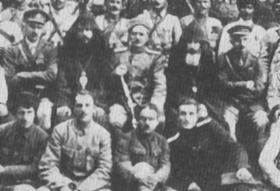
On March 3, the Grand vizier Talat Pasha signed the Treaty of Brest-Litovsk with the Russian SFSR. It stipulated that Bolshevik Russia cede Batum, Kars, and Ardahan. These lands had been captured by Russia during the Russo-Turkish War (1877–1878). The treaty also stipulated that Transcaucasia was to be declared independent. In addition to these provisions, a secret clause was inserted which obligated the Russians to demobilize Armenian national forces.[30]

Between March 14 – April 1918 the Trabzon peace conference held among the Ottoman Empire and the delegation of the Transcaucasian Diet (Transcaucasian Sejm). Enver Pasha offered to surrender all ambitions in the Caucasus in return for recognition of the Ottoman reacquisition of the east Anatolian provinces at Brest-Litovsk at the end of the negotiations.[31] On April 5, the head of the Transcaucasian delegation Akaki Chkhenkeli accepted the Treaty of Brest-Litovsk as a basis for more negotiations and wired the governing bodies urging them to accept this position.[32] The mood prevailing in Tiflis was very different. Tiflis acknowledge the existence of a state of war between themselves and the Ottoman Empire.[32]
On May 11, a new peace conference opened at Batum.[31] At this conference Ottomans extending their demands to include Tiflis as well as Alexandropol and Echmiadzin which they wanted a railroad to be built to connect Kars and Julfa with Baku. The Armenian and Georgian members of the Republic’s delegation began to stall. Beginning on May 21, the Ottoman army moved ahead once again. The conflict led to the Battle of Sardarapat (May 21–29), the Battle of Kara Killisse (1918) (May 24–28), and the Battle of Bash Abaran (May 21–24). On June 4, the First Republic of Armenia was forced to sign the Treaty of Batum. Although the Armenians managed to inflict a defeat on the Ottomans at the Battle of Sardarapat, the Ottoman army won the later battle and scattered the Armenian army. It four days after the fruitless German-mediated peace conference between the Ottoman and Transcaucasian governments was closed in Batumi on May 24, 1918. On May 26, 1918, Georgia withdrew from the federation and declared itself a separate republic with the encouraged by the German mission led by Friedrich Freiherr Kress von Kressenstein and Friedrich Werner von der Schulenburg. This was followed by Azerbaijan Democratic Republic. The proclamation of the independence of Democratic Republic of Georgia followed with the treaty of Poti on May 28. On May 28 First Republic of Armenia declared its independence.
In June, the Republic of Armenia was forced to sign the Treaty of Batum. However under the leadership of Andranik Ozanian Armenians in the mountainous Karabag region resisted the Ottoman 3rd army throughout the summer and established the Republic of Mountainous Armenia.[33] In August, they set up an independent government in Shusha, the administrative center of the region.
In June, The arrival of the German troops in Georgia coincided with the growing German-Ottoman rivalry for Caucasian influence and resources, notably the oilfields at Baku.[34] Early in June 1918, the Ottoman army under Vehip Pasha renewed its offensive on the main road to Tiflis, and confronted a joint German-Georgian force. On June 10, the 3rd Army attacked and took many prisoners, leading to an official threat from Berlin to withdraw its troops and support from Ottoman Empire. The Ottoman government had to concede to German pressure and to halt, for the moment, a further advance into Georgia, reorienting its strategic direction towards Azerbaijan and Iran.[35] The German mission left for Constanţa, taking with them a Georgian delegation composed of Chkhenkeli, Zurab Avalishvili, and Niko Nikoladze, who were entrusted by the Government of Georgia with negotiating a final treaty in Berlin. This negotiations rendered abortive by the military defeat of Germany in November 1918.
.jpg)
In July, Enver Pasha had bigger goals than just reconquest of land lost 40 years ago. He ordered the creation of a new force in March 1918. This force was named as the Army of Islam. In reality, it was not even a Corps size. This force, numbering between 14,000 and 25,000 strong, was composed entirely of Muslims, and most spoke Turkish. In July, he ordered the Army of Islam into Centrocaspian Dictatorship, with the goal of taking Baku on the Caspian Sea. This new offensive was strongly opposed by the Germans. Germany regarded all of southern Russia as theirs by right of conquest. Enver's Army of Islam marched to the Azerbaijan Democratic Republic. They got as far as Baku on the Caspian Sea. They threw the British out in September 1918 at the Battle of Baku.

In October, Ottoman troops responded to General Andranik's defiance and pursued him between Mountainous Karabagh and Zangezur. The conflict was fierce, but indecisive. The Armenian militia under Andranik's command decimated an Ottoman unit trying to advance to the Varanda River. The armed conflicts between these units continued until the Armistice of Mudros. The Armistice of Mudros brought General Andranik the chance to create a base for further expansion eastward and form a strategic corridor extending into Nakhichevan.[36]
On October 30, The Armistice of Mudros was signed and the Caucasus Campaign ended. By the end of the war, the Ottoman Empire, although it lost Persian Campaign, Sinai and Palestine Campaign and Mesopotamian Campaign, had re-captured all the territory which they lost to the Russians in Eastern Anatolia.
Armenian Genocide
During the Caucasus Campaign, Turkish Armenia was depopulated of its entire Christian/Armenian population as part of an Ottoman plan, now widely referred to as the Armenian Genocide, to weaken the Russo-Armenian Alliance, as only Muslims, who were loyal to Turkey, would remain. The Armenian population had two choices: be herded like cattle on long death marches to camps in the middle of the Syrian desert to die of disease, abuse by guards, massacres, Kurdish raids along the way, and starvation or, if they refused, be indiscriminately massacred, raped and Islamized right then and there. Both scenarios accomplished the goal of the Ottoman Turks, removal of Armenians from their homelands to continue their occupation of Western Armenia. The population removals and massacres resulted in the deaths of 1.5 million Armenians, with other estimates being between 800,000 and 1,800,000, the destruction of thousands of years of Armenian heritage in the form of monasteries, churches, cemeteries, houses, schools, and other buildings, a massive expansion of the Armenian Diaspora in countries like France and the United States, and the continuous 100-year long contention between the modern day states of Turkey and Armenia.[37][38]
According to J. Rummel, the Young Turks killed 1,883,000 Christians, including Armenians, Greeks and Nestorians from 1914 to 1917. In turn, at least 128,000 Muslims were killed by Russian troops and Armenian irregular units during the period between 1914-1915 and a further 40,000 Muslims were killed by Russian troops of Armenian descent in the region occupied by Russian Empire between 1917 and 1918.[39]
Historian Uğur Ümit Üngör, the author of Confiscation and Destruction: The Young Turk Seizure of Armenian Property, noted that during the Russian invasion of the Ottoman Empire, many atrocities were carried out against the local Turks and Kurds by the Russian army and its Armenian volunteer units.[40] A large part of the local Muslim Turks and Kurds fled west after the Russian invasion of 1916.[41]
Aftermath
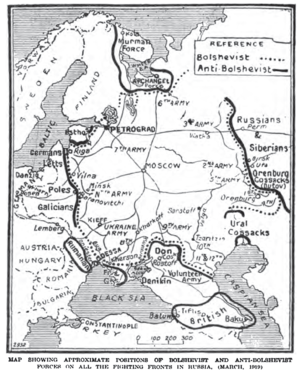
The Ottoman Empire lost the war to the Allies, but the borders in the Caucasus were not settled. Two years after the armistice, a peace treaty was signed between the Allied and Associated Powers and Ottoman Empire at Sèvres on August 10, 1920.
Territorial disputes
After the war, The Georgian-Armenian War 1918 soon followed over the Javakheti and Lori provinces, with Armenia gaining the latter. Armenia and Azerbaijan engaged in the Armenian-Azerbaijani war (1918 - 1920) over Karabakh and Nakhichevan, with Armenia losing both due to Soviet intervention in favor of the Anti west Turkish National Movement. The Turkish–Armenian War of 1920 resulted in the occupation/depopulation of even more Armenian land.
Sovietization of Caucasus

On April 27, 1920, the government of Azerbaijan Democratic Republic received a notice that the Soviet army was about to cross the northern border and invade ADR. In the west, there was a war over Karbakh with Armenia; in the east, the local Azeri communists were rebelling against the government; and to the north the Russian Red Army was steadily moving southward having defeated Denikin's White Russian forces. ADR officially surrendered to the Soviets, but many generals and local Azeri militias kept resisting the advance of the Soviet forces and it took a while for the Soviets to stabilize the newly proclaimed Azerbaijan Soviet Socialist Republic. On December 4, 1920, the government of the First Republic of Armenia effectively surrendered. On December 5, the Armenian Revolutionary Committee (Revkom) made up of mostly Armenians from mountainous Karabakh entered the city. On December 6, Felix Dzerzhinsky's dreaded secret police, Cheka entered Yerevan, thus effectively ending all existence of the DRA.[42] The Armenian Soviet Socialist Republic was proclaimed, under the leadership of Aleksandr Miasnikyan. On February 25, 1921, the Soviet destruction of the Democratic Republic of Georgia happened.
On October 23, 1921, the end of hostilities came with the Treaty of Kars. It was a successor treaty to the earlier Treaty of Moscow of March 1921.[43] and was ratified in Yerevan on September 11, 1922.[44] The Soviet Union signed the Treaty of Kars, which was a treaty between the Grand National Assembly of Turkey, which had declared Turkey a republic in 1923, and representatives of Bolshevist Russia, Soviet Armenia, Soviet Azerbaijan, and Soviet Georgia (all these states formed part of the Soviet Union after the December 1922 Union Treaty) in 1921.[43][44]
See also
Footnotes
- 1 2 Fleet, Kate; Faroqhi, Suraiya; Kasaba, Reşat (2006). Turkey in the Modern World. The Cambridge History of Turkey. 4. Cambridge University Press. p. 94. ISBN 0-521-62096-1.
- ↑ Erickson, Edward J. (2007). Ottoman Army Effectiveness in World War I: a comparative study. Taylor & Francis. p. 154. ISBN 0-415-77099-8.
- ↑ See cited numbers on the following pages: Bergmann Offensive (40,000), Battle of Sarikamish (25,000), Battle of Manzikert (1915) (10,000), Battle of Kara Killisse (1915) (8,000), Erzurum Offensive (5,000), and Battle of Erzincan (12,000).
- ↑ See cited numbers on the following pages: Bergmann Offensive (14,000) Battle of Sarikamish (135,000), Battle of Manzikert (1915) (6,000), Battle of Kara Killisse (1915) (16,000), Erzurum Offensive (15,000), and Battle of Erzincan (34,000).
- 1 2 Hinterhoff, Eugene (1984). Persia: The Stepping Stone To India. Marshall Cavendish Illustrated Encyclopedia of World War I. 4. New York: Marshall Cavendish Corporation. pp. 499–503. ISBN 0-86307-181-3.
- 1 2 3 Pollard, A. F. (1920). "The first winter of the war". A Short History of the Great War. London: Methuen.
- 1 2 3 The Encyclopedia Americana. 28. 1920. p. 403.
- ↑ Bobroff, Ronald Park (2006). Roads to glory – Late Imperial Russia and the Turkish Straits. London: I.B. Tauris. p. 131. ISBN 1-84511-142-7.
- ↑ Hovannisian, R. G. (1967). Armenia on the Road to Independence, 1918. Berkeley and Los Angeles: University of California Press. p. 59.
- ↑ Kayaloff, Jacques (1973). The Battle of Sardarabad. Near and Middle East Monographs. 10. Paris: Mouton. p. 73. ISBN 3-11-169459-3.
- ↑ Nansen, Fridtjof (1976). Armenia and the Near East. Middle East in the Twentieth Century. New York: Da Capo Press. p. 310. ISBN 0-306-70760-8.
- ↑ Boghos Nubar the president of the "Armenian National Assembly" declared to Paris Peace Conference, 1919 through a letter to French Foreign Office – December 3, 1918
- ↑ "First World War.com - Feature Articles - Who Declared War and When". www.firstworldwar.com. Retrieved 2016-06-17.
- ↑ Erickson, Edward J. (2001). Ordered to Die: A History of the Ottoman Army in the First World War. Westport: Greenwood. p. 54. ISBN 0-313-31516-7.
- ↑ Shaw, Ezel Kural (1977). History of the Ottoman Empire and Modern Turkey. New York: Cambridge University Press. pp. 314–315. ISBN 0-521-21280-4.
- ↑ Tucker, Spencer (1996). The European Powers in the First World War: An Encyclopedia. New York: Garland. p. 174. ISBN 0-8153-0399-8.
- ↑ "the delay enabled the Russian Caucasus Army to concentrate sufficient force around Sarikamish"
- 1 2 Pasdermadjian, Garegin; Aram Torossian (1918). Why Armenia Should be Free: Armenia's Role in the Present War. Hairenik. p. 22.
- ↑ Balakian, Peter (2003). The Burning Tigris: The Armenian Genocide and America's Response. New York: HarperCollins. p. 200. ISBN 0-06-019840-0.
- 1 2 Hinterhoff, Eugene. Persia: The Stepping Stone To India. Marshall Cavendish Illustrated Encyclopedia of World War I, vol iv. pp. 1153–1157.
- ↑ Safrastian, A. S. (January 1916). "Narrative of Van 1915". Journal Ararat. London.
- ↑ Allen, W. E. D.; Muratoff, Paul (1999). Caucasian Battlefields: A History of Wars on the Turco-Caucasian Border, 1828–1921. Nashville: Battery Press. pp. 361–363. ISBN 0-89839-296-9.
- ↑ Serge, Victor (1972). Year One of The Russian Revolution. Chicago: Holt, Rinehart and Winston. p. 193. ISBN 0-7139-0135-7.
- ↑ Allen, W. E. D.; Muratoff, Paul (1999). Caucasian Battlefields: A History of Wars on the Turco-Caucasian Border, 1828–1921. Nashville: Battery Press. p. 458. ISBN 0-89839-296-9.
- ↑ Chalabian, Antranig (1988). General Andranik and the Armenian Revolutionary Movement. Southfield, MI. p. 318.
- ↑ Yerasimos, Stefanos (2000). Kurtulus Savası’nda Türk-Sovyet iliskileri 1917–1923 (in Turkish). Istanbul: Boyut Kitapları. p. 11. ISBN 975-521-400-3.
- ↑ Swietochowski, Tadeusz (1985). Russian Azerbaijan 1905–1920: The Shaping of National Identity in a Muslim Community. New York: Cambridge University Press. p. 119. ISBN 0-521-26310-7.
- ↑ Gökay, Bülent (1997). A Clash of Empires: Turkey between Russian Bolshevism and British Imperialism, 1918–1923. London: Tauris Academic Studies. p. 12. ISBN 1-86064-117-2.
- ↑ Çaglayan, Kaya Tuncer (2004). British Policy Towards Transcaucasia 1917–1921. Istanbul: Isis Press. p. 52. ISBN 975-428-290-0.
- ↑ Hovannisian, Richard G. (2004). The Armenian People from Ancient to Modern Times. 2. New York: St. Martin's Press. pp. 288–289. ISBN 1-4039-6422-X.
- 1 2 Shaw, Ezel Kural (1977). History of the Ottoman Empire and Modern Turkey. New York: Cambridge University Press. p. 326. ISBN 0-521-21280-4.
- 1 2 Hovannisian, Richard G. (2004). The Armenian People from Ancient to Modern Times. 2. New York: St. Martin's Press. pp. 292–293. ISBN 1-4039-6422-X.
- ↑ Malkasian, Mark (1996). Gha-Ra-Bagh!: The Emergence of the National Democratic Movement in Armenia. Detroit: Wayne State University Press. p. 22. ISBN 0-8143-2604-8.
- ↑ Busch, Briton Cooper (1976). Mudros to Lausanne: Britain’s Frontier in West Asia, 1918–1923. Albany: SUNY Press. p. 22. ISBN 0-87395-265-0.
- ↑ Erickson, Edward J. (2001). Ordered to Die: A History of the Ottoman Army in the First World War. Westport: Greenwood. p. 187. ISBN 0-313-31516-7.
- ↑ Malik, Hafeez (1994). Central Asia: Its Strategic Importance and Future Prospects. New York: St. Martin's Press. p. 145. ISBN 0-312-10370-0.
- ↑ "Tsitsernakaberd Memorial Complex". Armenian Genocide Museum-Institute.
- ↑ Forsythe, David P. (11 August 2009). Encyclopedia of human rights (Google Books). Oxford University Press. p. 98. ISBN 978-0-19-533402-9.
- ↑ J. Rummel, Rudolph (1998). Statistics of Democide: Genocide and Mass Murder Since 1900. LIT Verlag Münster. pp. 82, 83. ISBN 9783825840105.
- ↑ Horne, John (2013). War in Peace. Oxford University Press. pp. 173–177. ISBN 9780199686056.
- ↑ Levene, Mark (2013). Devastation. Oxford University Press. pp. 217, 218. ISBN 9780191505546.
- ↑ Hewsen, Robert H. (2001). Armenia: A Historical Atlas. Chicago: University of Chicago Press. p. 237. ISBN 0-226-33228-4.
- 1 2 "Text of the Treaty of Kars" (in Russian). Archived from the original on April 24, 2007.
- 1 2 "English translation of the Treaty of Kars". Archived from the original on January 27, 2001.
References
- Falls, Cyril (1960). The Great War pp. 158–160. (covers 1915 fighting)
- Fromkin, David (1989). A Peace to End All Peace, pp. 351–355. Avon Books. (covers 1918 operations)
- Harutyunian, The 1918 Turkish aggression in Transcaucasus, Yerevan, 1985. (covers conquest of Armenia, 1918)
- Pollard, A. F. (1920). A Short History of the Great War (chapter 10). (covers 1916 fighting)
- Strachan, Hew (2003). The First World War, pp. 109–112. Viking (Published by the Penguin Group) (1914 operations)
- Ulrichson, Kristian Coates (2014). The First World War in the Middle East (Hurst, London) (The Caucacus Campaigns, Chapter 3 pp53–74)
- Russian Campaign in Turkey
External links
| Wikimedia Commons has media related to Caucasus Campaign. |